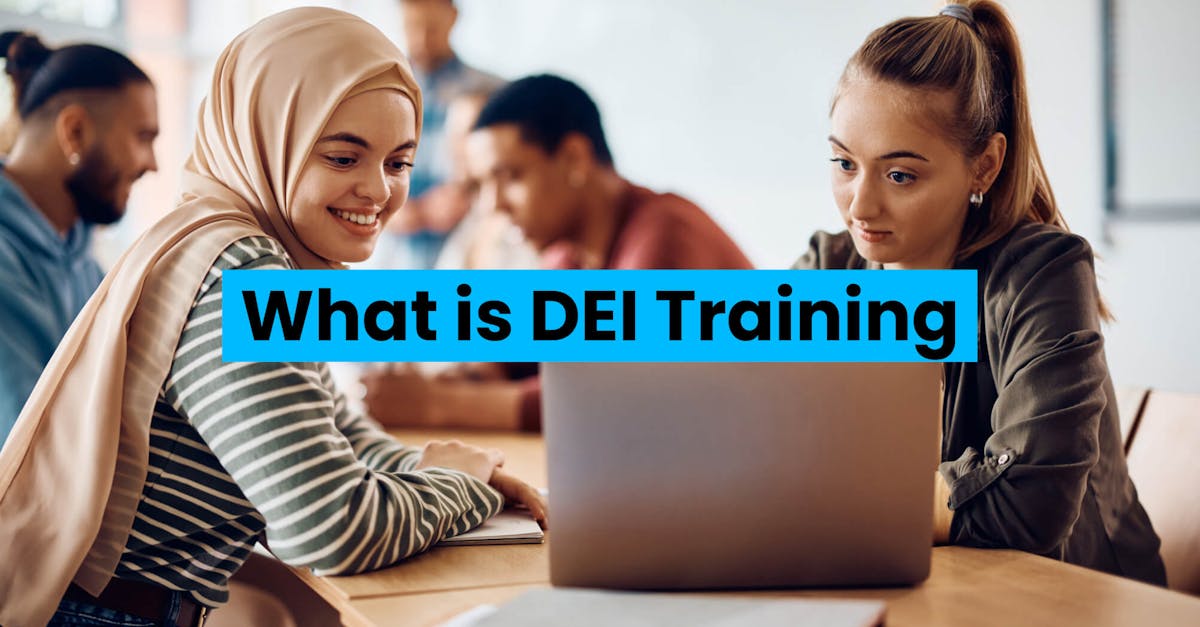What is DEI training: a guide to diversity, equity, and inclusion training

Diversity, equity, and inclusion (DEI) training is a vital tool in today's workplaces. It aims to create diverse, inclusive, and equitable environments where every employee feels respected, valued, and has equal opportunities.
In this article, we’ll explore DEI training’s meaning, its significance, key components, and the different approaches. We’ll also dive into how its effectiveness is measured, the challenges it faces, and what the future holds for this essential aspect of modern organizations.
What is DEI training?
Diversity, Equity, and Inclusion (DEI) training is a training process implemented by organizations to promote diversity, equity, and inclusion in the workplace. It involves giving employees the knowledge, skills, and tools necessary to create a more diverse, inclusive, and equitable work environment.

DEI training for employees aims to address issues related to bias, discrimination, and underrepresentation within the organization. It encompasses activities, brochures, and initiatives that raise awareness about diversity-related issues, foster inclusion, and reduce bias and discrimination.
As a whole, it helps enhance workplace culture and promote equal opportunities for all employees.
Examples of DEI topics to include in your training
When developing a Diversity, Equity, and Inclusion (DEI) training program, it's essential to cover a wide range of topics to guarantee comprehensive training and awareness. Here are some examples of DEI topics to include in your training, as well as why they’re important and their benefits:

1. Unconscious Bias Training:
- Importance: Unconscious bias affects decision-making, hiring, and overall workplace dynamics. Training helps identify and mitigate these biases.
- Benefits: Trainees become aware of their biases through ethical training programs, leading to fairer and more inclusive decision-making and interactions.
2. Cultural Competence:
- Importance: Understanding various cultures and customs promotes a welcoming environment for all employees.
- Benefits: Trainees learn to appreciate diversity, build stronger cross-cultural relationships, and enhance teamwork.
3. LGBTQ+ Inclusion:
- Importance: LGBTQ+ employees often face discrimination and bias. Inclusion training makes sure that you have a safe and welcoming environment.
- Benefits: If not a member of the community, your learners can become allies, creating a more supportive workplace for LGBTQ+ colleagues.
4. Equal Opportunity and Affirmative Action:
- Importance: Legal compliance is vital for fair employment practices.
- Benefits: Trainees understand the legal framework and contribute to a workplace free from discrimination.
5. Mental Health and Well-being:
- Importance: Mental health issues can be stigmatized and overlooked in the workplace. That’s why it’s important to have this training topic included for DEI training.
- Benefits: They’ll learn to recognize signs of mental health issues, reduce stigma, and offer support when needed.
6. Age Diversity:
- Importance: Each generation brings unique perspectives and skills to the workplace.
- Benefits: They’ll gain insights into working effectively across generations, fostering innovation and collaboration.
7. Conflict Resolution:
- Importance: Conflicts arising from diversity can harm workplace relationships.
- Benefits: Your learners can acquire conflict resolution skills specific to DEI issues, helping maintain a harmonious workplace.
8. Diversity in Recruitment and Retention:
- Importance: Attracting and retaining diverse talent is essential for innovation and business success.
- Benefits: Trainees learn strategies to attract, support, and advance a diverse workforce, enhancing an organization's reputation.
9. Accessibility and Accommodations:
- Importance: Securing accessibility for all employees, including those with disabilities, is a legal and ethical requirement.
- Benefits: Trainees create an inclusive environment by understanding and implementing accessibility measures. This can also help with improving overall work performance since everyone will be given the best access to work.
10. Community Engagement:
- Importance: Encouraging employees to engage with their communities fosters social responsibility. Having an easily accessible training program can help foster this.
- Benefits: Trainees develop a sense of purpose, contribute to the community, and promote positive company branding.
11. Monitoring and Evaluation:
- Importance: Regular assessment guarantees DEI initiatives are effective.
- Benefits: Trainees can fine-tune and adapt DEI efforts, creating a more inclusive and equitable workplace over time.
By covering these topics in DEI training, organizations empower their employees to understand, embrace, and support diversity and inclusion. This not only creates a more equitable and harmonious work environment but also positively impacts business outcomes, employee morale, and the company's reputation.
It benefits trainees by making them more aware, empathetic, and equipped to navigate the complexities of a diverse workplace, ultimately fostering personal and professional growth.
DEI training programs to check out
Now that you know what topics you need to add, you may be looking for DEI training programs to deliver to your team. Luckily, EdApp has a ton of training resources in the course library for you to check out. Here’s the best of them:
Karamo’s Diversity, Equity, and Inclusion Training
The DEI training course begins with an introduction to the concepts of diversity, equity, and inclusion. It then proceeds to explore the topic of unconscious bias in the workplace. Karamo gives valuable insights on actionable measures for individuals and teams to foster inclusivity. This can offer guidance on both recommended actions and common pitfalls to avoid.

The course also offers essential lessons on identifying and addressing microaggressions, as well as strategies for advocating for oneself and supporting others. The final segment of the course centers on the transformation of the workplace into a secure and welcoming environment for all employees.
Equal Employment Opportunity
Having equal employment opportunities within companies is a crucial step towards nurturing an inclusive workplace, particularly for marginalized groups such as ethnic minorities and individuals with disabilities.

EdApp's Equal Employment Opportunity course empowers your leaders with a comprehensive understanding of equal opportunity, workplace discrimination, harassment, and violence. Armed with this knowledge, managers can craft workplace policies and initiatives that actively promote equal opportunity.
Additionally, should any unfortunate incidents happen, your teams will be well-prepared to conduct thorough and appropriate investigations.
Diversity and Inclusion
This DEI training course delves into critical themes, including diversity, inclusion, unconscious bias, and the art of establishing an inclusive organization that fosters a profound sense of belonging among employees.

Included in EdApp’s content library, this program equips teams with effective communication skills, making sure they interact without unintentionally causing offense. The lesson on affirmative and inclusive language imparts valuable tips to support this endeavor.
Apart from that, by embracing this diversity training course, you can harness the advantages of a diverse and inclusive workforce. This cultivates a thriving workplace where your team can learn, collaborate, grow together, and represent a varied spectrum of workers.
How to be a Team Player
Strong teamwork plays an important role in sustaining a productive and diverse workforce. EdApp's DEI training course, "How to be a Team Player," delivers an excellent foundation for individuals eager to enhance their teamwork skills. It also helps break down barriers within their teams and gain insights into the perspectives of their peers.

Through engaging microlessons, participants will explore various subjects, including team fundamentals, diverse viewpoints, effective communication, and adept conflict resolution. The course concludes with a final assessment, allowing learners to assess their grasp of the covered material.
Diversity and Inclusion in Retail
"Unlocking Inclusivity in Retail" is a tailor-made course by EdApp, exclusively curated for the retail sector. This dynamic program champions the virtues of a workplace that celebrates diversity, equality, and inclusivity. It equips your teams to create a shopping experience that truly resonates with every customer.

Through engaging content, the course navigates the uncharted territories of bias awareness, empowering your employees to be more attuned to the needs of a diverse clientele.
It firmly reinstates the significance of a zero-tolerance policy against discrimination and presents valuable guidance on active listening to customers. It's all about fostering an inclusive retail space where every shopper feels valued and welcome.
What is Gender and Why Gender Equality
Unraveling Gender: Embracing Equality is the last but not the least among our DEI Training Courses, brought to you by EdApp. This course doesn't just skim the surface; it plunges headfirst into the captivating world of gender diversity and LGBTQ disparities. It's a deep dive into the heart of gender, exposing stereotypes and misconceptions.

Additionally, it doesn't just tell your learners about the significance of gender equality; it shows them how they can actively champion the cause. As the curtain falls on this transformative journey, it reinforces vital terminology and definitions, leaving learners with a profound and holistic understanding of the paramount concept of gender equality.
This course is all about inspiring, empowering, and educating, taking your team on an exhilarating ride through the realms of gender diversity.
EdApp is a mobile learning management system designed for today’s digital habits, delivering more engaging and effective micro-learning directly to learners anytime and anywhere.
Sign up for this DEI training tool today.
Author
Stephanie Escuadro
Stephanie is an eLearning content writer for EdApp, a microlearning solution designed for today's digital habits. She creates content about cutting-edge learning technologies and resources to help companies deliver great training experiences. When not absorbed in writing, she spends her time taking care of her dog and binge-watching.
